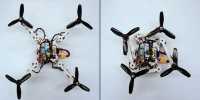Rolling out the Next Generation of Nanocars of International Nanocar Race
In anticipation of the next international Nanocar Competition in 2022, researchers are continuing to advance the technology of single-molecule machines with a new variety of nanocar pumps. Nanomechanics at Rice University and the University of Houston is getting ready to rev their engines for the second international Nanocar Race.
For the second Nanocar Race worldwide, Rice University will drive a brand new vehicle. The one-molecule car has an eternal dipole which simplifies its management. The team of Rice is going on with new prototypes in the American Chemical Industry Journal of Organic Chemistry, while the tires are to be pumped for a little longer than they planned since the race has been hollowed by 2022.
Nanomechanics at Rice University and the University of Houston is getting ready to rev their engines for the second international Nanocar Race. The ultimate aim of the competition is to advance the production of nanomachines that are capable of proper work, such as transporting molecular cargo and encouraging Nano-manufacturing.
In anticipation of the next international Nanocar Competition in 2022, researchers are continuing to advance the technology of single-molecule machines with a new variety of nanocar pumps. Nanomechanics at Rice University and the University of Houston is getting ready to rev their engines for the second international Nanocar Race.
For the second Nanocar Race worldwide, Rice University will be driving a brand new vehicle. The one-molecule car has an eternal dipole which simplifies its management. Although the brakes will have to be pumped a little longer than anticipated, with the sprint bumped to 2022 a year the Rice-based team is moving ahead with new prototypes introduced in the American Chemical Society’s Journal of Organic Chemistry.
This year’s versions are even smaller, marginally more than the minimum of 100 atoms mandated by the new regulations. “The car we used in the first race had only 50 atoms,” Tour said. “This is also a huge improvement in molecular weight, as expected by the revised criteria. “It is possible that the race organizers have tried to slow us down since the last time we completed the 30-hour race in just 1,5 hours,” he added.
In order to get the cars beyond 100 atoms while streamlining their synthesis, the researchers used a modular process to produce five new cars with either all tert-butyl, all adamantyl wheels (as in previous nanocars), or variations of the two. At 90 atoms, the cars with only butyl wheels, which reduced track interactions, and the shorter frame, were too small.
The nanocars will again be powered by a team headed by Professor Leonhard Grill from the University of Graz in Austria. The team took the Rice vehicle over the finish line in 2017 and has extensive experience in tunnel scanning with microscope-directed manipulations, Tour said. The Grill and Tour groups will meet again for the race in France. The ultimate aim of the competition is to advance the production of nanomachines that are capable of real work, such as transporting molecular cargo and encouraging Nano-manufacturing.
“This race pushes the limits of molecular nanocar design and methods to control them,” Tour said. “So through this competitive process, worldwide expertise is elevated and the entire field of nanomanipulation is encouraged to progress all the faster.”
A pandemic postponed the race, initially scheduled for next summer,. The racers will also have to meet in France to be monitored by the referees, but both teams will monitor their cars over the internet on tracks under tunnel scanning microscopes in their home laboratories.
“So the drivers will be together and the cars and trucks will be dispersed around the world,” Tour said. “But the distance of each track will be identical, to within a few nanometers.”
The Rice-Graz entry won the 2017 race with an asterisk, as his car crossed so fast to the surface of gold that it was difficult to catch pictures to judge. The team was then allowed to compete on a silver surface that gave ample resistance and finished the 150-nanometer race in 90 minutes. “The course was supposed to have been only 100 nanometers, but the team was penalized to add an extra 50 nanometers,” Tour said. “Eventually, it was no barrier anyway.”
The first prize on the Gold Track went to a Swiss team that finished a 100-nanometer race in six and a half hours. Tour’s lab developed the world’s first single-molecule car in 2005 and has gone through several iterations since the associated production of molecular motors that drill through cells to transport drugs.
Alexis van Venrooy, a graduate student of Rice, is the author of the article. The co-authors are Rice alumnus Victor García-López and John Tianci Li. Dubrovskiy is an assistant professor of chemistry at the University of Houston-Clear Lake and an academic visitor to Rice. Tour is for the T.T. And, uh, W.F. Chair in Chemistry and Professor of Informatics and Materials Science and NanoEngineering at Rice. The Army Research Laboratory, the Discovery Institute, and the Welch Foundation funded the research.
















